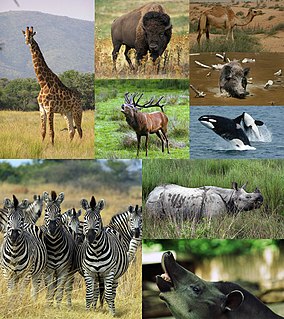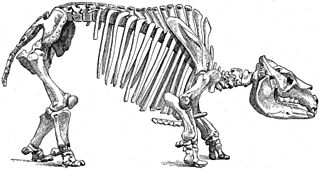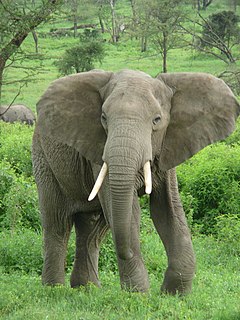 W
WUngulates are members of a diverse clade of primarily large mammals with hooves. These include odd-toed ungulates such as horses, rhinoceroses and tapirs, and even-toed ungulates such as cattle, pigs, giraffes, camels, sheep, deer, and hippopotamuses. Cetaceans are also even-toed ungulates, although they do not have hooves. Most terrestrial ungulates use the tips of their toes, usually hoofed, to sustain their whole body weight while moving.
 W
WArtiofabula is a clade made up of the Suina and the Cetruminantia. The clade was found in molecular phylogenetic analyses and contradicted traditional relationships based on morphological analyses.
 W
WCetancodontamorpha is a total clade of artiodactyls defined, according to Spaulding et al., as Whippomorpha "plus all extinct taxa more closely related to extant members of Whippomorpha than to any other living species". Attempts have been made to rename the clade Whippomorpha to Cetancodonta, but the former maintains precedent.
 W
WThe Cetruminantia are a clade made up of the Cetacodontamorpha and their closest living relatives, the Ruminantia.
 W
WThe long-nosed peccary is an extinct mammal species of the peccary family (Tayassuidae). It is one of two peccary-species that existed in the US-Midwest during the last ice age.
 W
WMeridiungulata is an extinct clade with the rank of cohort or superorder, containing the South American ungulates Pyrotheria, Astrapotheria, Notoungulata and Litopterna. It is not known if it is a natural group; it is known that both Litopterna and Notoungulata form a clade based on collagen evidence, but the placement of the other members is uncertain. it was erected to distinguish the ungulates of South America from other ungulates. Relationships between the orders inside Meridiungulata remain unresolved and it could well be a "wastebasket taxon". Most Meridiungulata died out following the invasion of South America by North American ungulates and predators during the Great American Interchange, but a few of the largest species of notoungulates and litopterns survived until the end-Pleistocene extinctions. The notoungulate Mixotoxodon was able to invade North America to as far as present-day Texas.
 W
WNotoungulata is an extinct order of mammalian ungulates that inhabited South America during the Paleocene to the Holocene, living from approximately 57 Ma to 11,000 years ago. Notoungulates were morphologically diverse, with forms resembling animals as disparate as rabbits and rhinoceroses. Notoungula were the dominant group of ungulates in South America during the Paleogene and early Neogene. Their diversity declined during the Late Neogene, with only the large toxodontids persisting until the end of the Pleistocene. Several groups of Notoungulates separately evolved ever growing teeth like rodents and lagomorphs, a distinction among ungulates only shared with Elasmotherium.
 W
WPaenungulata is a clade of "sub-ungulates", which groups three extant mammal orders: Proboscidea, Sirenia, and Hyracoidea (hyraxes). At least two more possible orders are known only as fossils, namely Embrithopoda and Desmostylia.
 W
WWhippomorpha is a suborder within Artiodactyla that contains all modern cetaceans and hippopotamuses, as well as their extinct relatives. All descendants of the last common ancestor of Hippopotamus amphibius and Tursiops truncatus are contained in Whippomorpha, making it a crown group. The placement of Whippomorpha within Artiodactyla is a matter of some contention, as hippopotamuses were previously considered to be more closely related to Suidae, while whales were thought initially to be marine reptiles, and later classed as ungulates. However most modern phylogenetic and morphological studies link hippopotamuses with cetaceans, and genetic evidence has overwhelmingly supported an evolutionary relationship between Hippopotamidae and Cetacea.